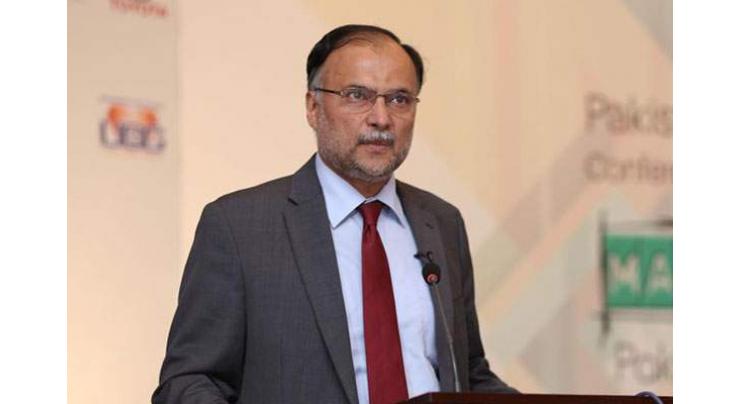
Economic Long March From August 11 To Mark Two-year Of Vision 2025: Ahsan Iqbal
Fahad Shabbir (@FahadShabbir) Published August 01, 2016 | 08:03 PM

ISLAMABAD, (UrduPoint / Pakistan Point News - 1st Augst,2016) : Federal Minister for Planning, Development and Reforms, Ahsan Iqbal on Monday announced to launch an economic long march on August 11 on completion of the second year of the government's Vision 2025 programme. "We will not only present scorecard of our achievements during the last two years but also explain our targets for next 10 years," he said while addressing a press conference here. He said,"Our opponents talk about political long marches but the country needs a decade of continuity in policies for sustainable economic development." The Minister expressed the confidence that after 2018, the next government would continue to implement 10 years road-map initiated by present government. He said, the country could not achieve economic prosperity unless it increased productivity, quality and innovation. About protest rallies announced by opposition parties, he said, these attempts would miserably fail as people were interested in development and prosperity of the country. He pointed out that people of the country had supported policies of the government during elections of local bodies, by-polls, Gilgit-Baltistan and Azad Kashmir and asked the opponent to respect the people's verdict. Ahsan Iqbal said, the entire nation was focussed on vision of progress and development being carried out under the dynamic leadership of Nawaz Sharif.
Pakistani people had always rejected the negative politics, he said and added, Imran Khan should give attention to improve performance of his provincial government of PKP. He said, the confidence of foreign investor has increased into policies of present government after three years performance of this government. The Minister said, transparency international had also expressed confidence into policies of the government which had successfully turned around the economy.
He said, the Vision 2025 was announced two years ago after complete consultation with all the stakeholder while provinces were also taken on board to make the country a model economy.
Pakistan, he said, was being termed as emerging economy and all the international organizations including Newsweek were viewing us a turned-around economy. He gave statistics regarding GDP growth, increase in remittances, Karachi Stock Exchange (KSE). Ahsan Iqbal said, out of US$ 46 billion under China Pakistan Economic Corridor (CPEC), projects worth US$ 10 billion had hit the ground while remaining schemes were in the pipeline. Giving details of power production in next few years, he said, 3600 MW electricity to be produced through LNG, would be available by June next, adding, the Jamshoro power project being completed by Asian Development Bank would start producing 1320 MW by year 2018. He said, 1320 MW Port Qasim Power Project being completed under CPEC and 1320 MW Sahiwal Power Project would start producing electricity in next year. Work was under progress on 2000 MW Thar project and 1320 MW HUBCO project which would be completed by the year 2018-19, he added. About infrastructure development, he said, motorway from Havalian to Thakot and Multan-Sukkur of Lahore-Karachi motorway was being completed at a fast pace. On the Western route, the road from Burhan to DI Khan would be completed by June 2018, he said and added, the Gilgit-Baltistan was working on environmental economy.
He said, the new government in Azad Kashmir would also start development projects. Ahsan Iqbal mentioned about work on Dasu and Diamir-Bhasha dams and also generation of wind and renewable energy. He said, Pakistan railway was being modernized with Rs.117 billion investment while number of PIA aircraft had been doubled. Responding to a question, he said, unemployment was decreased from 6.24 percent in 2013 to present 5.94 percent,adding, while the country witnessed reduction in poverty. He said, Rs.173 billion were allocated for improvement in the existing transmission and distribution systems to bear burden of increased electricity production in next two years.
Related Topics
Recent Stories

Price Control Magistrates conduct crackdown against price hike

14 stolen bikes recovered, gang leader arrested

GCWU Sialkot VC meets Punjab governor

World Immunization Week kicks off in Mirpurkhas

President for stronger economic, cultural ties with China

Imad Wasim expected to take part in fourth T20I match against New Zealand

Ayubia chairlift closure inflicts heavy losses on traders

N. Macedonia starts elections that could decide stalled EU talks

Illegal occupation of land: Court confirms interim bail of PTI leader

Football: English Premier League result

Four dead as floods wreak havoc in Kenyan capital

PTI backed SIC nominates Hamid Raza for role of PAC chairman
More Stories From Pakistan
-

Price Control Magistrates conduct crackdown against price hike
5 minutes ago -

14 stolen bikes recovered, gang leader arrested
5 minutes ago -

GCWU Sialkot VC meets Punjab governor
5 minutes ago -

World Immunization Week kicks off in Mirpurkhas
5 minutes ago -

President for stronger economic, cultural ties with China
5 minutes ago -

Ayubia chairlift closure inflicts heavy losses on traders
18 minutes ago
-

Illegal occupation of land: Court confirms interim bail of PTI leader
18 minutes ago -
LGH committed to quality healthcare under Punjab govt's vision
18 minutes ago -
University of Education holds workshop on education policy development
18 minutes ago -
Study visit of Social Solidarity and Inclusion of Timor-Leste to BISP
18 minutes ago -
DIG Hazara directs to increase security measures across the region
28 minutes ago -
Pakistan, Portugal discuss bilateral, regional, global issues
28 minutes ago






